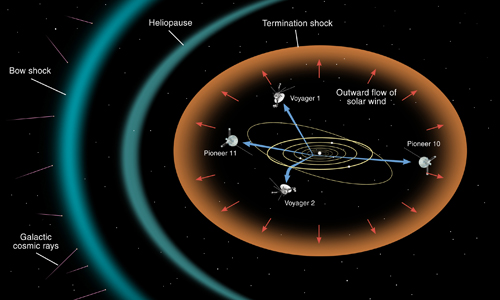|
Introduction
The Solar System is the realm of the Sun.
It consists of a number of different objects.
- The Sun itself. The Sun is a star that we see from close up. It is a huge ball of glowing gases with
a mass over 330,000 that of the Earth. Indeed all the other objects in the Solar System put together have a mass of less than
1% that of the Sun.
- Eight Major Planets (also known as Classical Planets). These orbit the Sun at various
distances and include the Earth. The major planets revolve around the Sun in elliptical orbits that are, for the most part,
nearly circular. These orbits are roughly in the same plain.
- Numerous Satellites. Most of the planets have satellite systems (moons). The Earth has a single Moon;
Venus has none while Jupiter and Saturn have dozens. Some satellites are as big as the smaller planets; others are irregularly
shaped rocks a few kilometers in size.
- A multitude of Minor Planets.
- Asteroids (or Planetoids) orbit in the inner solar system mainly between the orbits
of Mars and Jupiter. Some are found close to the Sun among the inner planets. A few actually go around the Sun in the orbit
of a planet like Jupiter (these are called Trojans). Several orbit among the outer planets and these are
called Centaurs. A few are large enough to be spherical but most are irregular in shape. They are mainly
made up of rock, metal or carbon.
- Kuiper Belt Objects (KBOs). These are icy worlds orbiting in the outer solar system beyond the major
planets. The larger ones are spherical. Pluto is the most famous KBO (it was once classified as a planet) and it possesses
satellites. Many have markedly elliptical orbits, often not in the plane of the orbits of the major planets.
- The Comets. These are icy and rocky bodies that orbit the Sun in highly elliptical orbits that are very
inclined to the plane of the orbits of the major planets. When they pass close to the Sun, they heat up and materials in the
comet evaporate and produce a stream of dust and gases. This is the tail of the comet which always points away from the Sun.
The Solar System does not include the stars.
PLANETS:
Five planets have been known since ancient times. During the 16th and 17th Centuries, the Earth was added to the list
of planets when it was realised that it was also orbiting the Sun. Since then, two more planets have been found making a total
of eight. These eight worlds orbit the Sun. Most have moons or satellites orbiting them.
Two types of major planets:
The Terrestrial Planets are small and solid (like the Earth) and are made of rock and metal. The are also
called the Inner Planets because they are fairly close to the Sun. They have no or very few satellites. In
order from the Sun, these planets are Mercury, Venus, Earth and Mars.
The Jovian Planets are also known as the Gas Giants. This is because they are large
and mainly gaseous. Another name for them is the Outer Planets, because of their great distances from each
other and the Sun. They have large systems of satellites (like mini solar systems) and ring systems, that of Saturn being
particularly spectacular. These planets, in order from the Sun, are Jupiter, Saturn,
Uranus and Neptune.

|

